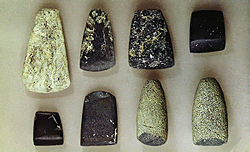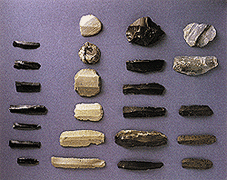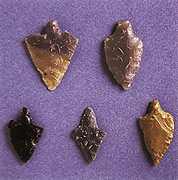 
Stone tools were from the Palaeolithic Period essential in order for Man to be able to engage in various economic activities. The transition during the Neolithic Period to the productive stage necessitated from the 7th millenium BC a quest for and the manufacture of new types of tools, of different materials, developing skills and fully meeting new needs. On the basis of the type of raw materials used and the techniques required for their working two classes of tools have been distinguished: chipped and polished stone tools. |
|
The method of percussion was used on materials which produced flakes
and blades, such as flint and obsidian.
During the Neolithic blades
were produced from varieties of resistant flint (jasper, light coloured
flints) and from Melian obsidian. The distribution of Melian obsidian
in all the regions of Greece resulted from an extensive network of exchanges,
while sources of flint remained in many cases unknown, thus the conditions
for its distribution are somewhat obscure. Blades were used in the early
phases of the Neolithic as independent knives or with bone or antler
handles. Flint blades in particular were attached one next to the other
on a wooden shaft, thus functioning as a sickle, and were replaced after
many uses. Blunt blades though did not fall into disuse, but were used
again as scrapers. |
|
During the Late Neolithic the increased use of obsidian for the manufacture of drills and scrapers, arrow heads (southern Greece, Cyclades) but also spears is remarkable. Triangular or leaf-shaped arrow heads of obsidian form a particularly small class of finds in circulation, probably as "prestige symbols", from the Peloponnese and the Aegean Islands and as far as Macedonia. |

The appearance of tools of polished crystalline or schistose rocks went hand in hand with the beginning of the farming and stock-rearing stage in Greece (7th millenium BC) and their use was intensive both during the Neolithic and the Bronze Ages. In metamorphic rocks (e.g. serpentines) tools used as axes, adzes and chisels were manufactured with hammering, polishing, abrasion and sawing. Their use depended on the direction of the cutting edge of the tool in relation to the haft. The haft, that is the part to which the tool was attached to facilitate its use, was mainly from deer antler. M illstones and grinders, essential for wheat milling, were manufactured from crystalline rocks. Millstones were also used as work surfaces for the manufacture of jewellery. Finally, "maceheads" (skullbrakers) belong to the polished tools of the Late Neolithic, that is stone spheres with a hole, from which a rope was tied to rotate the sphere and thus enabling it to be hurled more effectively. This earlier attempt at interpreting the function of "maceheads" has in all probability to be revised, since their manufacturing material is quite special and rare. They may probably have been objects of "social prestige", that characterized the last phases of the Neolithic. |

